Key takeaways:
- Art residencies foster creative growth by providing essential resources, mentorship, and community support, enabling artists to experiment without typical pressures.
- Networking opportunities during residencies can lead to significant professional growth through connections with mentors and curators.
- Residencies come in various forms, such as studio-based, thematic, and community-focused, each offering unique experiences that enhance artistic practices.
- Successful applications require clarity, customization for specific residencies, and personal storytelling to connect with the selection panel effectively.
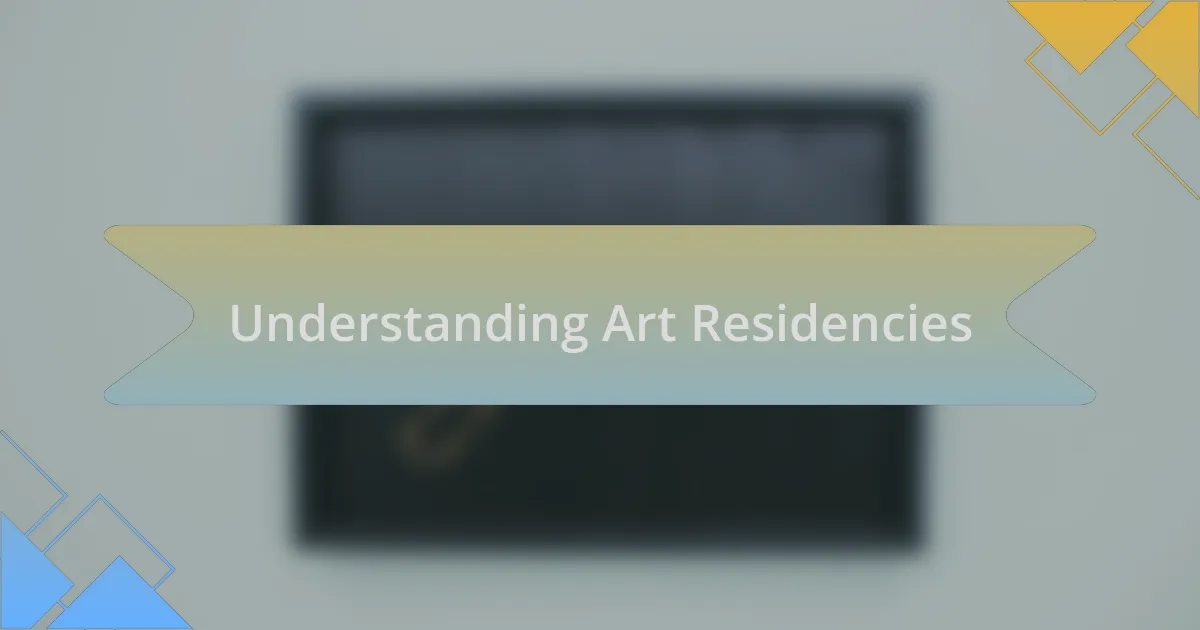
Understanding Art Residencies
Art residencies serve as temporary sanctuaries for artists, offering a unique environment that encourages creative growth and exploration. I still remember my first residency; I was surrounded by artists from different disciplines, and it felt like stepping into a vibrant tapestry of creativity. Isn’t it fascinating how such diverse interactions can spark ideas we might not encounter in isolation?
These programs often provide not just space but also resources—materials, mentorship, and even funding. I’ve found that having access to specialized tools can completely transform a project. Have you ever wished for just a little more time and support to develop an idea? That’s the beauty of a residency; it removes barriers and invites experimentation without the usual pressures.
Additionally, art residencies create a sense of community that can be both nurturing and challenging. I recall sharing my work-in-progress and receiving constructive feedback from peers, which sometimes pushed me out of my comfort zone. How often do we get the chance to receive such candid critiques in our daily lives? This blend of support and challenge is key to personal and artistic growth, making each residency a unique chapter in an artist’s journey.
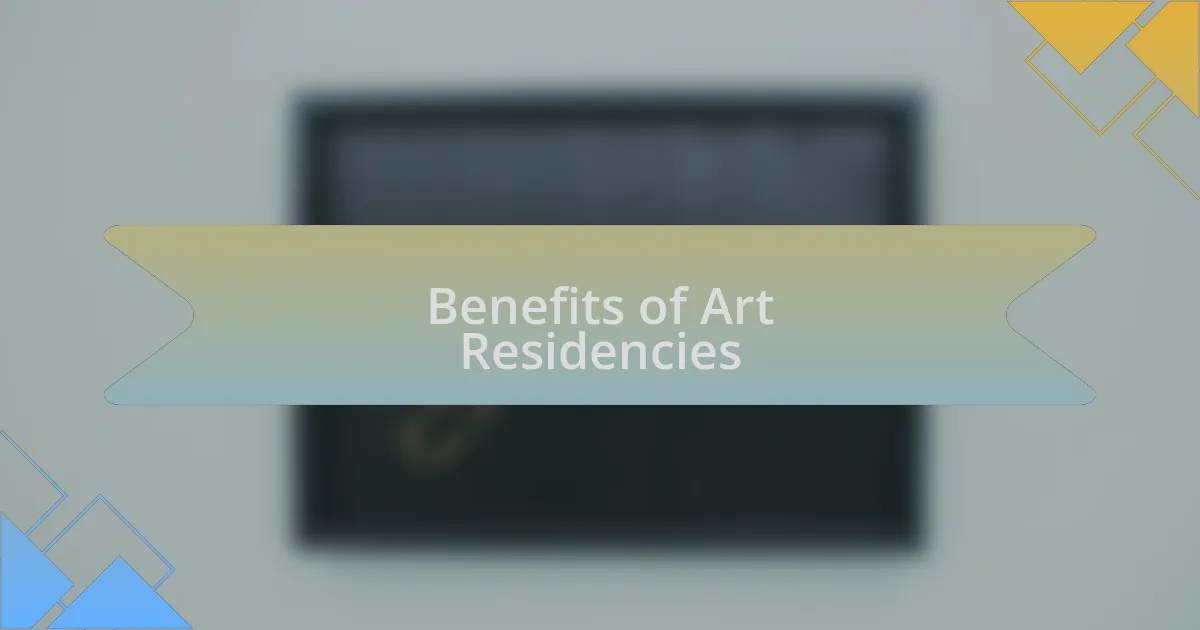
Benefits of Art Residencies
Art residencies often provide invaluable networking opportunities, connecting artists with mentors, curators, and even collectors. During my time at one residency, I had a chance encounter with a curator who appreciated my work and invited me to exhibit. It’s moments like these that highlight the potential for professional growth; aren’t we all looking for those chance meetings that might change the trajectory of our careers?
Furthermore, the immersion into a focused artistic environment can be incredibly rejuvenating. I remember stepping away from my daily distractions and committing fully to my art—each day felt like a mini-retreat. Is there anything quite like that feeling of being completely present and dedicated to your craft? The clarity gained during such periods often leads to breakthroughs that aren’t easily replicated in our regular routines.
Moreover, many residencies culminate in exhibitions or public presentations, offering artists a platform to showcase their work. I still recall the nervous excitement of sharing my finished pieces with a wider audience; it was both terrifying and exhilarating. This exposure not only builds confidence but also opens doors for future opportunities. Isn’t it rewarding to realize that your journey is not just a solitary endeavor, but one that has the potential to resonate with others?

Types of Art Residencies
Art residencies come in various forms, each designed to cater to different needs and creative practices. For instance, I’ve participated in studio-based residencies, where the emphasis was on creating new work in a supportive environment. This type often allows for extended periods of focused creation, encouraging a deep exploration of one’s artistic voice. What would it feel like to lose yourself completely in your art for an entire month?
Another fascinating type is thematic residencies, which center around specific subjects or concepts. During one of these, I engaged with fellow artists who were all exploring the theme of sustainability in their practices. This collective focus sparked dynamic conversations and collaborations that challenged my perspectives. Isn’t it amazing how sharing ideas within a common framework can elevate our work in unexpected ways?
Lastly, community-based residencies emphasize engagement with the local population. In a residency I attended, we were encouraged to collaborate directly with the surrounding community, which enriched my understanding of art’s role in social discourse. It was an eye-opening experience; how can our art not only reflect our inner worlds but also speak to and uplift those around us? This interaction reminded me that art is not just a solitary endeavor but deeply intertwined with the experiences of others.
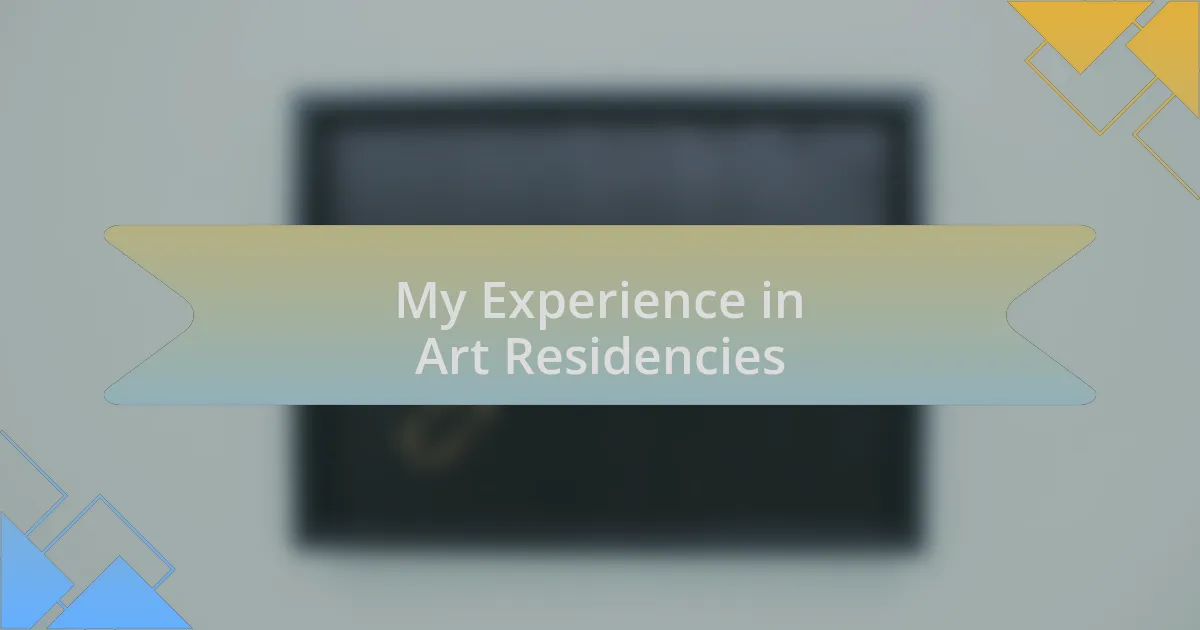
My Experience in Art Residencies
During my time in art residencies, I was often amazed at how quickly a shared space could blossom into a vibrant creative community. In one particular residency, I remember staying up late in the studio, bouncing ideas off a fellow artist and realizing that we spoke the same creative language. It was in those hours of collaboration that I crafted a piece that transformed my approach to sculpture, blending our perspectives in ways I hadn’t anticipated.
I also experienced profound moments of introspection during quieter residencies. In a remote location surrounded by nature, I found myself deeply connected to the environment. One evening, I sat by the river, sketching the shapes of the trees reflected in the water. This moment made me question how much of my work had been influenced by my surroundings before and inspired me to draw directly from my experiences in nature, allowing my work to echo the beauty of my environment.
Then there are those times when the pressure of a deadline heightens the creative process. I distinctly remember scrambling to complete a project just moments before the exhibition opening, my heart racing with both anxiety and excitement. Navigating that tightrope of urgency taught me a valuable lesson: sometimes the magic happens when we push ourselves to our limits. What if that thrill and pressure could be harnessed to consistently spark creativity? This realization has transformed how I approach all my projects moving forward.
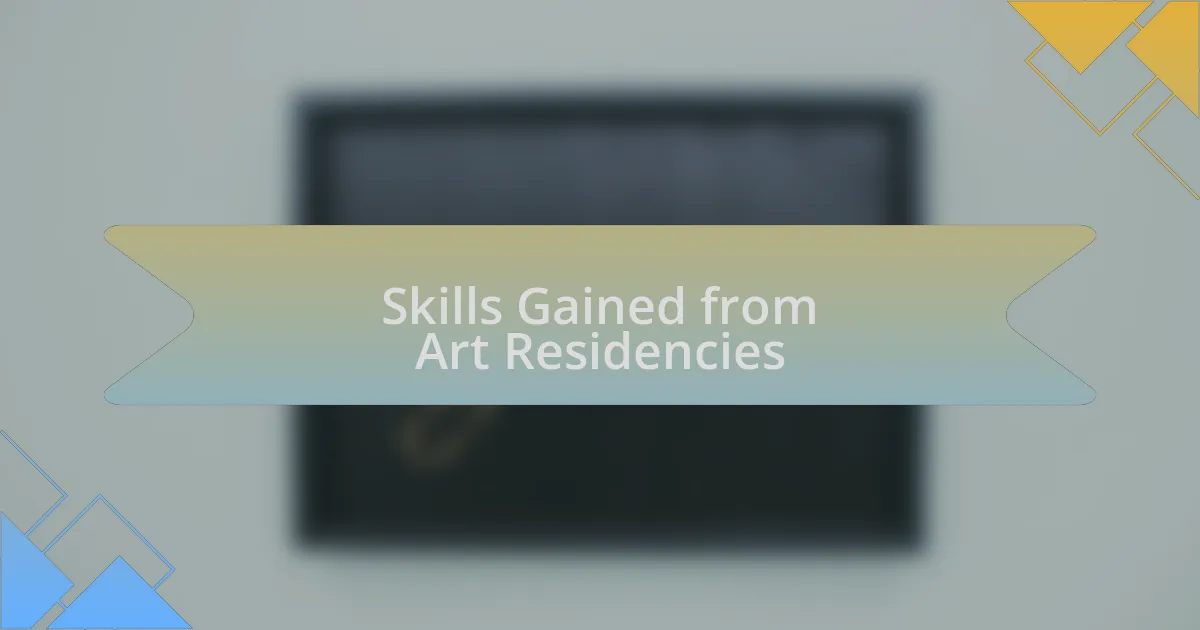
Skills Gained from Art Residencies
Engaging in various art residencies allowed me to hone my technical skills in ways I hadn’t anticipated. One residency focused on new materials, and I remember the exhilaration of experimenting with resin for the first time. As I mixed colors and shapes, I felt like a kid in a candy store, realizing just how much experimentation can lead to unexpected and exciting outcomes in sculpture.
Collaboration, too, became a powerful skill I developed over time. In another residency, I teamed up with a ceramicist to merge our practices. The day we held a joint workshop, where we challenged each other’s techniques, left me with a newfound appreciation for the creative dialogue that can happen when artists come together. How often do we push ourselves out of our artistic comfort zones? That experience taught me the importance of being open to others’ perspectives and the incredible synergy that can emerge from such partnerships.
Moreover, navigating the logistical challenges of an art residency was enlightening. I remember nearly losing my mind trying to organize materials and deadlines, yet it was this struggle that sharpened my project management skills. I often wonder if many of us underestimate the behind-the-scenes work that art demands. Balancing creative freedom with structured planning truly shaped my ability to execute larger projects confidently, reminding me that this balance is essential in the world of sculpture.
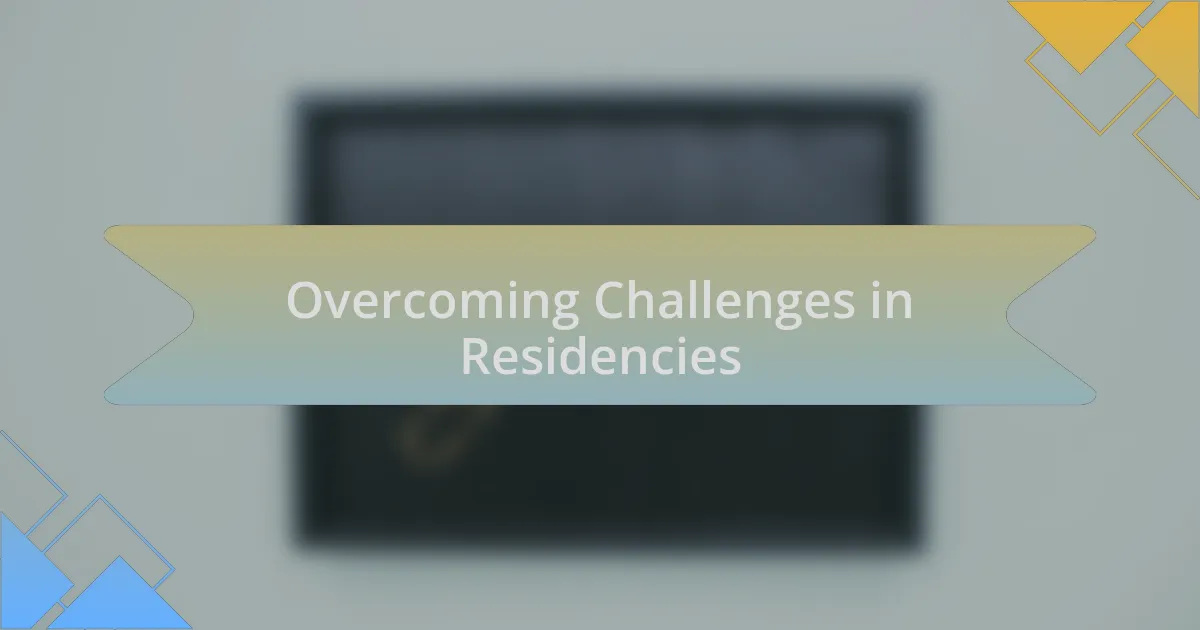
Overcoming Challenges in Residencies
One notable challenge I faced during my last residency was the solitude that can catch any artist off guard. I remember the evenings when I found myself staring at blank canvases, grappling with self-doubt. It was an uncomfortable yet profound moment, prompting me to explore how isolation can both stifle and ignite creativity. Have you ever experienced a similar struggle? I discovered that reaching out to fellow residents for feedback or even just to share a cup of coffee could transform my mindset. Connection became my antidote to isolation.
Technical hurdles also posed significant challenges that led to unexpected growth. In one particular instance, I experimented with a new sculpting software that seemed daunting at first. I can vividly recall the frustration of countless failed attempts and the urge to give up. But instead of letting it defeat me, I decided to dedicate a specific time each day to learn this software. As I slowly achieved breakthroughs, I recognized the importance of perseverance. How can we truly grow without facing obstacles?
Lastly, the diverse expectations from residency curators often felt overwhelming. I distinctly remember a week when feedback felt particularly harsh, leaving me questioning my direction. Instead of shrinking back, I embraced the critique as an opportunity for refinement. It transformed my process, and I began to see criticism not as a setback but as a guideline toward improvement. How do we define success if not by our ability to adapt and evolve? This realization empowered me and strengthened my artistic vision in ways I hadn’t anticipated.
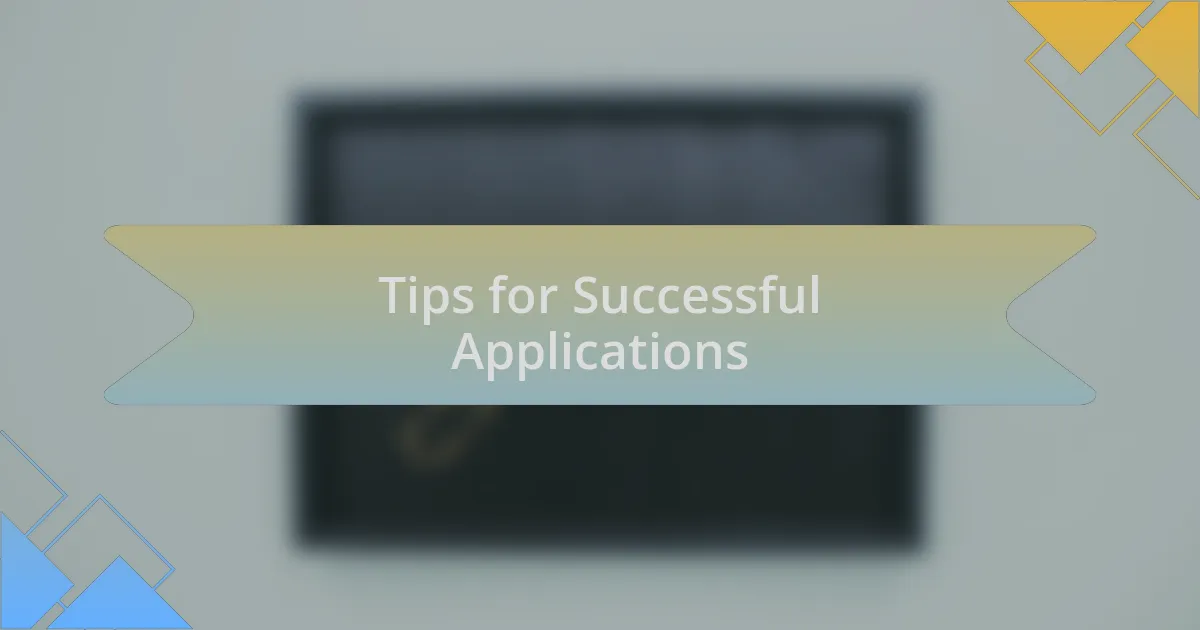
Tips for Successful Applications
When preparing your application for an art residency, clarity is paramount. I learned this lesson the hard way after submitting a proposal that was overly ambitious and vague. I realized the importance of articulating not only my vision but also the specific outcomes I hoped to achieve. Have you ever wondered why some applications stand out more than others? It often comes down to the ability to convey clear intentions that resonate with the jury.
Another key tip is to tailor your application to each residency. In one experience, I almost submitted a generic proposal, thinking it would save time. However, after doing some research into the specific themes and values of the program, I decided to customize my approach. This resulted in a more compelling proposal that felt genuine and connected to the residency’s mission. Isn’t it fascinating how a little extra effort can set your work apart?
Finally, I found that including personal storytelling can elevate an application significantly. For instance, I wrote about a project that stemmed from a deeply personal experience, sharing how it shaped my artistic journey. This not only made my application more engaging but also allowed the review panel to connect with me on a human level. Have you considered how your own story might resonate with others? Authenticity can be your strongest asset in making your application memorable.